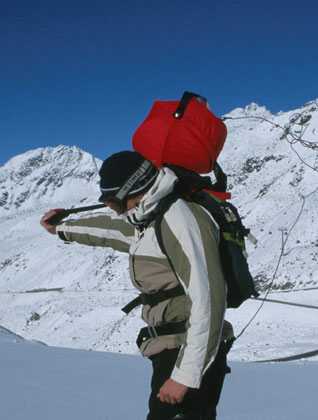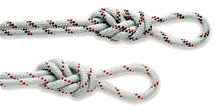Equipment |
|
| Transceivers | |
| The only realistic way of finding someone buried in the snow in time to save their life is with an avalanche Transceiver. | |
| Shovels | |
| Avalanche shovels are made of
aluminum or plastic. Some folks worry that the plastic ones will break, but I think the
bigger issue is that the plastic blades are often really tiny. If someone shows up on a
tour with a plastic shovel that looks like a toddler's beach toy--or no shovel at
all--offer to let him carry yours.
|
|
| Avalanche Probes | |
|
|
Probes can be used to pinpoint
avalanche victims you have located with a beacon. There have been many incidents in the
past where a lot of time was lost by digging near but not near enough to the victim.
Probes are also useful for locating a good place to dig a snowpit and can be used to feel
the buried snow layers and assess snow bridges over crevasses.
|
| Snow Tools | |
| A light weight snow saw is useful for isolating columns in snowpits and rutschblocks, sawing off cornices to test slopes and building igloos. Some of them will niftily screw onto the ski pole-probes I just talked you out of. Folding models take up less space and prevent the teeth from chewing your spare sweater, but some of the hinges are obnoxious and tend to collapse while you're using the saw. | |
| Releasable Binding | |
|
|
Skis or snowboards that remain attached during a ride in an avalanche work like levers, magnifying the twisting force on arms and legs and dragging you down to the deadly bottom of the debris. This is why professional Ski Patrollers are not allowed to use non-releasable bindings while doing avalanche control work. |
| Avalanche Cords | |
|
|
An old-fashioned, low-tech idea...avalanche cords are long strings that get tied to a person's leg and trail out behind him. The idea is that if the recreationist gets buried, some part of the cord will probably remain on the surface. Searchers can follow the directional arrows printed on the cord and locate the victim. |
| AvaLung | |
|
|
The AvaLung consists of a zippered mesh vest with handy pockets and a breathing tube attached to a snow filter on the side. The idea is that if you are caught and buried, the tube and one way valve allows you to vent your hot, CO2-rich breath out the back. This prevents CO2 narcosos and the icing up that ordinarily forms a fatal ice-mask that seals the porous snow, preventing you from breathing the supply of air that exists in even the densest snowpack. |
| Avalanche Air Bag | |
| Developed and used primarily in the Alps of Europe, air bags consist of a backpack with an inflatable "balloon" and small gas cartridge inside. If caught in an avalanche, you inflate the bag(s) by pulling a cord. The bouyancy and size of the balloon help keep you floating on top of the avalanche debris and may provide some protection from the trauma of colliding with rocks and trees. | |
| Recco Tags | |
|
Picture a small, cheap, metallic band-aid that emits a homing signal that can be used to locate the device when it is buried in an avalanche (or anywhere else, for that matter). |
| Avalanche Ball | |
 |
The Ball consists of a small
pouch that attaches to your back or pack. Inside the pouch is a collapsible, spring-loaded
ball attached to a 20' line. If you are caught, you pull a rip-cord that releases the
flattened ball which then expands and remains on the surface as an indicator of your
burial location.
|
| Rope | |
 |
100 feet of lightweight rope (7-8mm) weighs little and takes up very little space but comes in handy for belayed cornice jumping, ski cuts and pit-digging on sketchy slopes. |
| First Aid Supplies | |
| Anyone who has ever had to close a bloody gapper when their ski flew off and hacked a shin knows that a first-aid kit can be incredibly handy for keeping your socks dry.. | |
| Cell phone / Radio | |
| |
Please remeber that Cellphones do not work everywhere. Mountain radios are more reliable. Small, personal radios don't require a licensed frequency. They are an excellent tool in case of emergency.
|
Top
Index
Demonstration
Types
Scale Safety
Equipment Links
& Resources